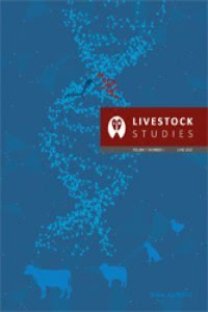Postpartum Sorunsuz Süt İneklerinde Prid Uygulaması Sonrası Ovaryum Ultrasonografisi ve Fertilite Parametrelerinin Değerlendirilmesi*
This study aims to evaluate the suitability of sonography for prediction of postpartum fertility and to find out the effects of PRID (Progesterone-Releasing-Intravaginal Device; 1,55 g progesterone and 10 mg oestradiol benzoat) on fertility parameters of cows in late postpartum. 30 healthy Holstein cows, which completed the postpartum period of 25 days, were used in the study. Uterus and cervix involutions were monitored by transrectal sonography at 7 day intervals between day 25 and day 46 postpartum. In this process, we assessed uterine and cervix involutions by measuring the longitudinal diameter of the uterine and cervix. As the result of these examinations, cows were divided into 2 random groups each consisting of 15 cows. Group 1 was inserted PRID intravaginally for 12 days and after the end of treatment, estrus was graded as severe intensity (+++), moderate intensity (++) and low intensity (+). Cows observed in behavioral estrus were artificial inseminated after 12 hours as a pre-ovulatory follicle was detected with rectal ultrasound and the results until third inseminations were evaluated in all groups. Pregnancy estimations were done at between 25-30 days and 45-60 days with ultrasound and rectal palpation after artificial insemination. Following the end of PRID treatment, it was detected that only one cow was observed estrus as low intensity (+). The percentage of oestrus as moderate intensity was determined 53.3 % for Group I and 26.7 % for control group. The estrus as severe intensity was determined 40.0 % and 73.3 % for Group I and II, respectively. The means diameter of pre-ovulatory follicle were 16.8±0.06 mm for Group I, and 18.8±0.15 mm for Group II. It was found that the intervals between the end of the PRID treatment and time of behavioral estrus were 2.00-10.26 days for Group I. Intervals between the end of treatment and conception were determined as 96.14±6.98 days and 83.33±5.39 days for Group I and II, respectively. The difference between these two groups was not statistically important (P>0.05). Conception after first insemination and total conception rates were 13.33 %; 60.0 % and 93.33 %; 100 % for Group I and 11, respectively. Service period was 154.14±6.98 days and 130.13±5.38 days for group I and II, respectively. The difference between these two groups was found statistically important (P
Anahtar Kelimeler:
Gebelik oranı, , Östrus belirlenmesi, , Prid, , Senkronizasyon, , Sütçü inekler,
___
- Akın Aİ (1999): Sığırlarda dölverim özellikleri. Türk Vet. Hek. Derg., 11: 22-24.
- Yayın Aralığı: Yılda 2 Sayı
- Başlangıç: 1959
- Yayıncı: Sezer ÖZ
Sayıdaki Diğer Makaleler
Dilek Aksu ELMALI, İsmail KAYA
MANDALARDA MASTİTİS VE SÜT VERİMİNE ETKİSİ (DERLEME)
